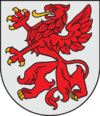 Alternate names: Jaunjelgava [Lat], Friedrichstadt [Ger], Fridrikhshtadt and Фридрихштадтъ [Rus], Frydrychsztat [Pol], Naira and פרידריכשטאַט [Yid], Nairi, Jaun-Yelgava, Yaunelgava, Jauna-Jelgawa, Jaunijelgaua, Jaunijelgava, Jaunjelgavas at 56°37' N, 25°05' E in Courland Region, 44 miles ESE of Riga. The municipality was formed in 2009 by merging Sece parish, Sērene parish, Staburags parish, Sunākste parish and Jaunjelgava town with its countryside territory the administrative centre being Jaunjelgava.
Alternate names: Jaunjelgava [Lat], Friedrichstadt [Ger], Fridrikhshtadt and Фридрихштадтъ [Rus], Frydrychsztat [Pol], Naira and פרידריכשטאַט [Yid], Nairi, Jaun-Yelgava, Yaunelgava, Jauna-Jelgawa, Jaunijelgaua, Jaunijelgava, Jaunjelgavas at 56°37' N, 25°05' E in Courland Region, 44 miles ESE of Riga. The municipality was formed in 2009 by merging Sece parish, Sērene parish, Staburags parish, Sunākste parish and Jaunjelgava town with its countryside territory the administrative centre being Jaunjelgava.
- Jewish Encyclopedia as Friedrichstadt [March 2009]
- Encyclopedia of Jewish Life (2001), p. 569: "Jaunjelgava".
- Jaunjelgava Jewish Citizens Fascist Victims List, 1941) [June 2014]
-
JewishGen Latvia SIG
Old (1803) and New (1848) CEMETERY: 12 Mezha St. cemetery. no signs. Take the road from Visikums to Zaiceva, 22km from Aluksne. On the left is the old Punkul road. There, turn for 1 km into the Akavinju mezs/forest. The site is before the old bridge on the Akavinas river.
The very large and old cemetery still exists. Many nice tombstones have artistic engravings of lions, and birds, etc. Mr. Feigmanis has pictures of all remaining stones. This email address is being protected from spambots. You need JavaScript enabled to view it., Kahovkas 2-12 LV-1021, Riga, Latvia
Restoration of cemetery on July 27, 2008: "Jewish community "Shamir" with support of EACEA (Education, Audiovisual and Culture Executive Agency) and the Shatz family announces completion of pilot project of Jaunjelgava Jewish cemetery reconstruction and conservation." A renovation/building of the Holocaust memorial within the cemetery was completed in Spring 2003. The area has very good soil, as the cleared parts of the cemetery become overgrown in a very short period of time. [March 2009]
3000 graves, 700 tombstones, chapel, cholera cemetery and memorial for Holocaust victims. The cemetery was established in 1848. After the WWI, the remains of Jaunjelgava Jews, who perished in Holocaust, were reburied in the NE part of the cemetery (mass grave: in part of the Jewish cemetery near the municipal cemetery). By the mid-1950s, the cemetery was covered with thick bushes. The boundaries were not visible. By the end of 1980s, the forest almost overtook the cemetery; some trees even grew through the tombstones. The Chapel lost its roof presumably during the military actions of WWII. In due course, the walls also started to ruin. see Source: Restoration project. [January 2011]
See burial list All Latvia Cemetery List and cemetery photo. [March 2009]
See burial list. [January 2011]
[UPDATE] KehilaLink [January 2016]
